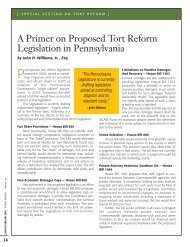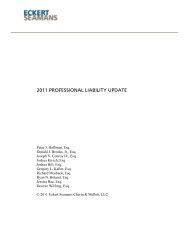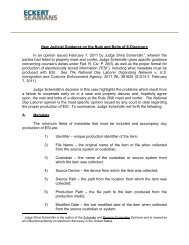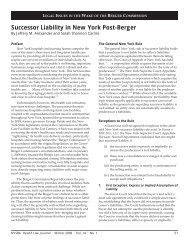2012 PROFESSIONAL LIABILITY UPDATE - Eckert Seamans
2012 PROFESSIONAL LIABILITY UPDATE - Eckert Seamans
2012 PROFESSIONAL LIABILITY UPDATE - Eckert Seamans
You also want an ePaper? Increase the reach of your titles
YUMPU automatically turns print PDFs into web optimized ePapers that Google loves.
manufacturing plant in Chickamauga, Georgia. Dow was required by the Occupational Healthand Safety Administration (“OHSA”) to provide free annual physicals to employees exposed tocertain levels of hazardous substances. Instead, Dow provided all of its employees with freephysicals that included chest x-rays. On May 8, 2003, Mr. Ward was provided a series ofphysical tests, including a chest x-ray. Mr. Ward later received a report regarding his x-rayresults which reported no abnormalities. The chest x-ray was interpreted by Dr. Levine, acontracted employee of Most Health, incorporated in Pennsylvania. A year later Mr. Ward diedfrom lung cancer.A motion for summary judgment was filed arguing that there was no duty owed by Dr.Levine to Mr. Ward as no physician patient relationship existed under Pennsylvania law. Thecourt cited five considerations in determining the existence of a doctor patient relationship as setforth in Althaus v. Cohen, 756 A.2d 1166 (Pa. 2000): “(1) the relationship between the parties;(2) the social utility of the actor’s conduct; (3) the nature of the risk imposed and foreseeabilityof the harm incurred; (4) the consequences of imposing a duty upon the actor; and (5) the overallpublic interest in the proposed solution.” Id. at 1169.In arriving at its holding the court weighed each consideration set forth in Althaus andrelied on the reasoning set forth in Doyle v. South Pittsburgh Water Co., 199 A.2d 875, 878 (Pa.1964):[w]hen a physician treats a patient who has been exposed to or whohas contracted a communicable and/or contagious disease, it isimperative that the physician give his or her patient the properadvice about preventing the spread of the disease that the duty of aphysician in such circumstances extends to those ‘within theforeseeable orbit of risk of harm; and that [i]f a third person is inthat class of persons whose health is likely to be threatened by thepatient, and if erroneous advice is given to that patient to theultimate detriment of the third person, the third person has a causeof action against the physician.Ward, 2008 U.S. Dist. LEXIS 61573 at *31-32 (internal quotations omitted).Therefore, the motion for summary judgment was denied and a doctor patientrelationship was established by the Court.(b)Contractual Liability of a Doctor to the PatientIn Vogelsberger v. Magee-Women’s Hospital, 903 A.2d 540 (Pa. Super. Ct. 2006),appeal denied, 917 A.2d 315 (Pa. 2007), Plaintiff had her uterus, which contained large fibroids,removed by Defendant physician. Plaintiff contended that the physician was also supposed toremove her ovaries due to her concern about her mother’s history of ovarian cancer. Defendantphysician testified that although he had obtained the Plaintiff’s consent to remove her ovaries,the treatment plan was for him to remove them only if he found during the surgery that she hadsignificant endometriosis on the ovaries. Both the informed consent form and the physician’spreoperative note indicated that the procedure to be performed was a TAH/BSO. Plaintiff9









